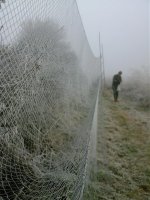Just come across this reply. Just the sort of reply i have now come to expect from you Peocile.
good, I like to be the harbinger of common sense.
How big is the site you ring at?
Just big enough for me to handle.
How many nets do you supervise AT ALL TIMES??
all of them, becasue if I am unable to supervise them then i don't erect them. Don't overstretch me sen and put the birds at risk, y'see. Like it says in the manual.
Do you sit and watch your net at all times?
You don't have to watch them to supervise them. But I do set them where I can see them, or control the approaches away from public areas, and nobody would have time to cut 20 birds out of them, that's for sure.
As i said before there were four ringers at the private site, nets were checked more than regularly.
but don't you see, it obviously wasn't regularly enough? Somebody had chance, and TIME, to cut out 20 BIRDS!!! (your words, my capitals). That, no matter what way you cut it, is slack.
The incident happened within about 10 minutes of a net round.
what does that mean? 10 mins after the last check (and how long between checks?)? Or nets were checked every 10 mins? Either way, it clearly wasn't enough.
You would surely be putting birds off if you are close enough to monitor the nets at ALL times?!
you don't have to be close. It all depends if you're supervising the nets or reading the paper. You can do either from 20m or 200m.
Bird Observatories ring birds all the time and theyre nets and heligolands are not supervised AT ALL TIMES due to the size of the site. So are you saying they should not erect nets there?
Heligolands are driven, so they don't need to be supervised as they're inactive until they're used. You know that. People also expect nets to be set up at observatories, and the signs usually say so. They also, from what I've seen, try to do it in out of the way areas. But if you're ringing near the public then you obviously take more care. By keeping the nets adequately supervised.
Look, I'm not bothered about a slanging match. No nets should be left long enough so that someone has time to cut out 20 birds. The ringer in charge is ultimately responsible for supervision, and they carry the can if the nets are unsupervised long enough for that to happen. It'd take a damn long time to cut out 20 birds. It's not about how often you check them. Every ringing site is different, and you cannot apply the same timings and regs to each. It's all about if your set-up is adequate. Net runs every 30 minsmight be adequate for a private estate, whereas every 5 might be more appropriate for a public park. The facts speak for themselves, and I'll say it again becasue I can't quite believe the slackness, if someone had time to cut out 20 birds from a mst net, then whatever regime you have, it is not adequate for that site imo.





